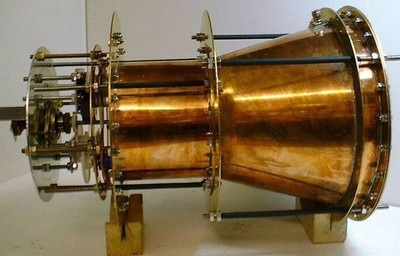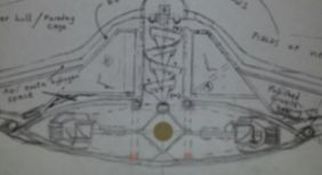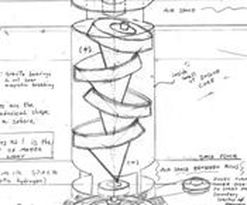The Vertical Cones have been tossed out and shelved, because it uses positive energy in a way that negative energy physics cannot define.
The impeller engine upgrade is shown in an article further down the page . . . (12/06/17)
I'm keeping this article however, to illustrate the difference in engine styles.
Asymmetrical di-electrostatic propulsion. (oops, see the bottom for correction)
. . .
The vertical core of cones had been re-oriented where the cylindrical housing magnets were all north facing in, and all the magnet polarities around the rim were north facing out (See: the home page, right under the big design image). That gives us an opposing north and south magnetic field on the inside and outside of the cone surface area. With a di-electrostatic aspect, this has interesting possibilities.
The magnets are in motion, compressing the frequency of the di-electrostatic field around the cone surfaces on one side (left) and expanding them on the other (right, or otherwise 180 degrees opposite to the rotating moving magneto-static compression -- the magnetic compression of static charge), moving a static field around the cone surface areas.
With a spark gap up top, derived from the spark collapse of di-electric, drawing the energy of plates in "vacuum collapse" from the Outer Ring transformers, a static charge can be delivered to the vertical core "vibration" engine of rotating and gyrating cones.
The di-electrostatic surface areas of the cones, all in rotation grounds to the Central Accumulator.
Quite a new aspect to all this.
The Cones can be made in asymmetrical capacitor style, terminating to a common edge (rim of the cone), and the middle point of each conic capacitor plate stacked along the central axis of each cone.
I'm going to work on this and engineer it in a new design based on negative energy physics to harness the propulsive static charge of the motion and movement of magneto-static inertia.
A lot of this is based on the "djed" designs from the people before the Egyptians.
There may be variations upon this, including a spark gap at the edges of each cone rim.
The concept however is to "compress the static inertia" down through the cone system. There will have to be a collapse of the static field nearing the bottom, where the static field draws in to the central ground. This compresses a static rotation into collapse, and into the center (Central Accumulator) of the transverse static vectors with the OTC-X1 rotating di-electric disk.
It therefore should accelerate the frequencies of the magneto-static electrogravity field to the central balance, as the warp drive engineering page discusses. Magnetic compression of static fields increases the frequency, also. In an inertial polarity from top down, the overall energy will raise in frequency like a Tesla transformer of another kind.
What does "di-electric" mean? It means "two conductive plates," basically, or a di-electric material. Telescopes sometimes have di-electric coated optics for enhancing light, kinda like a glowing cat eye. In contrast, magnets are normally di-polar (having two poles, a north and south). Sometimes a magnet can have just one pole (mono-polar), but as a secondary effect only (like touching only the north poles of a handful of magnets around one end of a steel pipe, making the steel pipe one north-pole-only magnet).
It seems to fit within theoretical parameters of the di-electrostatic warp drive principles.
Looks like the LAU-X3 physics are right around 100%
Corrections:
Oops! Seems the vertical cone stack is still acting as an asymmetrical monopole, not as a di-pole UNLESS YOU COUNT THE TIP OF THE CONE AND THE WIDE RIM AS A DI-POLE (of positive and negative energy). See the comments below.
ALSO:
It's pretty remarkable how similar the vertical core of cones are to the infamous EM drive NASA has verified as working.
The EM drive uses a radio frequency resonance cavity.
The vertical core of cones can be hollow inside (originally that was the case).
I just read an article showing the EM drive to move in the direction of the wide rim of its cone-shape; so the tip of the cone is the direction of thrust; rather, since there is no thrust generated, the cone shape points to where conventional Newtonian physics would say the force of thrust moves, pushing the ship in the opposite direction. It could be said that a gravity pocket forms on the wide side that the ship falls into, also. I will wait until there are more confirmations and more public general info in that area before posting a link.
EM Drive:
This is actually a verifiable basis for the vertical core of cones.
It's a simple concept, similar to yer basic asymmetrical capacitor.
What does high frequency radio / microwave band of EM waves do inside a metal chamber? It makes plasma.
Plasma is a high volt static force.
We're now seeing success with reactionless electrogravity engines. Nothing is really being reported other than a "slow lift" however. The OTC-X1 may increase the speed in relativistic mass reduction and gravity cancellation ways to compensate. Plus, the use of Tesla negative and positive energy systems has yet to be truly exposed in the public domain.
We may yet see an evolution of the vertical core into an impeller style, where the blades are around the inside edge of the cylinder, and open through the central vertical axis for increased magneto-electrostatic frequency capacity. Two capacitor plates closer together will transform very easily to higher volts, but farther apart they have more potential for the overall energy "amount" which would initially be lower frequency, unless more energy is built up in the static corridor.
Regardless, the general concept of the impeller: it is spun and accelerated and compressed, its inertia is forced into one direction of the spiral, to amplify the electrogravity impulse (di-electrostatic electrogravity propulsion internally acting as an external inertial field generator; it's a magneto-static inertial field generator, using air housed inside the engine spaces to generate the gravity-force that moves the ship, yet it can also work in a vacuum).
However with the experimental validation of a working EM drive, all over the world, the vertical core of cones do demonstrate a proof of concept.
With independent verification of Townsend Brown di-electric systems working in the vacuum, verified through several sources including from Honda engine tests (see the Construction page; scroll down to the words in bold font: "Townsend Brown"; there's a pdf), di-electric hull plating can serve as a viable form of maneuvering in the vacuum of space.
The superconductive nature of negative energy is still a little bit un-verified by multiple sources to confirm it, however its usage in modern warp drive theory, established by Alcubierre and is the primary reason for the formation of NASA EAGLEWORKS branch, the nature of di-electric and di-electrostatic energy fields (warp fields; warp bubbles; electromagnetic scalar energy fields) can be seen to easily apply toward electrogravity hull-plating dynamic-static-propulsion, for fast travel instead of a slow lift.
The hull plating layered ceramic (magnetic conductor) / dielectric conductor has been verified; See: Construction page. A magnetic aspect must be included with a di-electric aspect for performance of a di-electrostatic propulsion system in a vacuum. This very much stands to reason, keeping with the conventional electrogravity theory of rotating magnetic fields over an alignment of electric spin (like Dr. Ning Li's gravity device), but by using magneto-di-electrostatic fields instead of rotational magnetic fields.
Also in time, the Outer Ring system may evolve more toward an exotic light-generating field of zero mass, as more people share their independent research and experimental verification. However; experimentally, the ring may be divided into two halves / segments, with electrogravity rotational "impulse engines" like the EM drive between the halves along the outer ring zone (allows for rotation along the Z vertical ship axis, similar to a reaction control thruster, but reactionlessly and not expending mass to thrust in a direction). The two ring halves may cover 172 degree arcs each. That way there are definite start-finish points to work the frequencies (transformation; inertial polarization, etc). Yet just by rotating the charges on the outer hull plating, it might also rotate the ship by changing the spin polarity of the ship's [rotational aspect of] inertia.
As it is, the outer ring system is a negative energy field generator; similar to the OTC-X1, able to transmit an induced negative zeroed-out mass of the particle flows (air flows) from the ship engines through its magnetic field, and static-scalar field. It is also capable of resonating and generating as well as transforming energy, able to take the maximum amount of energy possible from engines and generators, and perpetuating it in the outer resonance ring, while also holding capacitance to power the hull plating, and to amplify energy from the engines. It serves multiple purposes.
The resonance fields generated from the engines is like a sound that vibrates. It can be conducted through the hull in a "resonance warp field" where all these engines can operate in harmony and in chorus together.
New research into negative energy systems is ongoing, although slowly developing since no one has ever known how to do it until JUST recently it was explained and demonstrated.
The beauty of all this is "if it works" means we learn more about the universe. And "because it works" we learn more about the universe.
The nature of dielectrics and electrogravity can mesh with the vertical core of cone monopole vortex dynamics for more of a high-powered electro-mechanical high-powered gravity engine.
Wow!
Why not just use negative energy for everything, generating the high volt radio frequencies, too?
The magneto-electrostatic energy will expand from a spark, or contract into a spark. Negative energy can transform positive energy states. Understanding the nature of the energy itself, what it is, how it moves, is it hard or is it soft, is it heavy or light . . . and that the nature of all things is the nature of energy itself, then all energy has inertia, and vibration and frequency . . . like poles of a static magnet, both polarized OR non-polarized.
Dynamically, the OTC-X1 utrons are double-terminated right angled cones -- exotic unification. The central accumulator is the source of positive energy to be transmuted, but at its heart is a spark gap to receive the collapse of that positive energy -- the negative of the energy -- and from that point explodes through the vertical core, in the same polarity, either self-contained or co-contained energy inertial frequency / systems.
The vertical core is a negative energy engine, but with polarities of positive and negative.
Positive energy doesn't pull on negative energy, or try to expand it. Negative energy however will collapse positive energy, and travel using the positive energy as a channel or current, in the sea of energy (wirelessly).
Energy has definite inertia.
From the vacuum point, plasmatic-mass force(charge) explodes with inertial force so to move in that direction . . . and also inertial energy already present is compressed at one end (the tip), the actual scalar space of the mass is squeezed at one end, compressing mass (or rather, inertia, which is of mass however), folding its counter-balance into itself; so to maintain the engine's balance, it has to move perpetually in one direction. ... it sucks itself along like a vacuum cleaner, just at the same time as inertial force explodes in one direction only. You just can't look at only what the energy is doing in one way, in order to understand the mechanics of it overall.
It behaves paradoxically in two ways at once, however in both ways there is the same direction of inertia.
It is incomprehensible just knowing the positive aspect of energy alone.
Utrons:
We can take another look at utrons. The EM cone moves in the direction of its wide end. The utrons then act as a negative compression force upon inertia, building up inertia in the center of the wide rimmed equator, but compressing it overall by di-electrical negative energy. So, inertial mass increases in the utrons and is reduced. Inertial energy is drawn into the utrons thereby lowering the inertial mass overall of the ship.
Being in direct opposition to each other as well, where inertial or gravitational forces oppose 180 degrees, the utrons have an effect upon the overall inertial field, whereas the central accumulator picks up the central pole of the most cancellation, increasing the overall frequency of negative mass [inertial] vibration.
That's the warp field itself, instead of trading frequency for momentum as in the EM cone (frequency is compressed asymmetrically -- on one side or end -- which trades momentum of one side to the other), momentum is traded out with mass with the utrons -- the more momentum, the less mass -- in the Utron/Accumulator rotating energy plane/space, which is a scalar field of shape, which creates an energy field of mass reduction within and therefore around it, as it has been explained, before.
The quantum nature of spin (acceleration/charge/energy) itself is significant, as well -- harnessing the energy of inertia and gravity, which also harnesses the force of mass, be it positive or negative, compressed or expanded (density), set into motion just like the spin of tiny particles creates the field in a magnet.
The EM Drive is essentially the proof of warp drive; rather, the EM Drive is used here to prove warp drive, specifically validating the engine design of the LAU-X class ship.
The LAU-X class ship uses these principles: mass is reduced therefore time speeds up, also the ship travels faster because there's less mass and moves faster with less force. Also, the central accumulator creates a large negative energy pole along-with the positive energy pole at the top of the ship, allowing for that fast-warp-speed of motion, without incurring the limiting effects effects of time through light-speed-and-beyond velocity, defeating the limitation of special relativity claiming the faster something travels at light speed, the slower in time it goes.
To note: by reducing mass, the inertial mass is reduced. So the faster the X-1 utron disk spins, it does not incur normal gyroscopic inertia. The OTC-X1 increases the frequency of time, and it floats over the surface of the Earth (levitation) when spinning. It becomes so light in density that it passes through objects and is able to move from the pressure and voltage (intentional energy) of thought itself, as a force.




 RSS Feed
RSS Feed